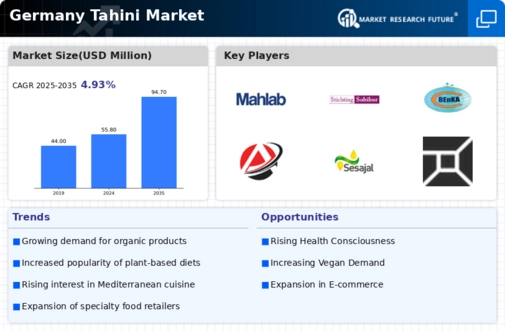Innovative Product Development
The tahini market in Germany is witnessing a surge in innovative product development, which is reshaping consumer engagement. Manufacturers are introducing a variety of tahini-based products, including flavored tahini, tahini spreads, and ready-to-use sauces. This diversification caters to evolving consumer preferences and enhances the versatility of tahini in everyday cooking. The tahini market is expected to experience a growth rate of approximately 9% by 2025, driven by these innovations. As consumers seek convenience and new flavors, the introduction of innovative tahini products is likely to play a crucial role in expanding the market.
Expansion of Ethnic Cuisine Popularity
The tahini market in Germany is benefiting from the growing popularity of ethnic cuisines, particularly Middle Eastern and Mediterranean dishes. As consumers become more adventurous in their culinary choices, they are increasingly exploring diverse flavors and ingredients. Tahini, a staple in many traditional dishes, is gaining traction as a key ingredient in hummus, baba ghanoush, and dressings. This trend is expected to contribute to a projected growth of 10% in the tahini market by 2025. The integration of tahini into mainstream cooking reflects a broader acceptance of global flavors, enhancing its appeal among German consumers.
Rising Demand for Plant-Based Products
The tahini market in Germany experiences a notable increase in demand for plant-based products. As consumers become more health-conscious, they are gravitating towards plant-based diets, which are perceived as healthier alternatives to animal-based products. This shift is reflected in the growing popularity of tahini, a versatile ingredient made from ground sesame seeds. In 2025, the market for tahini is projected to grow by approximately 15%, driven by its incorporation into various dishes, including salads, dips, and dressings. The tahini market benefits from this trend, as consumers seek nutritious and sustainable options that align with their dietary preferences.
Sustainability and Ethical Sourcing Trends
The tahini market in Germany is also influenced by the growing emphasis on sustainability and ethical sourcing. Consumers are becoming more discerning about the origins of their food, favoring products that are produced in environmentally friendly ways. This trend is prompting manufacturers in the tahini market to adopt sustainable practices, such as sourcing sesame seeds from certified organic farms. As a result, the market is likely to see an increase in demand for organic tahini products, with a projected growth rate of 8% by 2025. This shift towards sustainability aligns with the values of environmentally conscious consumers.
Increased Awareness of Nutritional Benefits
The tahini market in Germany is significantly influenced by the rising awareness of the nutritional benefits associated with tahini. Rich in healthy fats, protein, and essential vitamins, tahini is increasingly recognized as a superfood. This awareness is likely to drive sales, as consumers actively seek out foods that contribute to their overall well-being. In 2025, the tahini market may see a growth rate of around 12%, as more individuals incorporate tahini into their diets for its health benefits. The emphasis on nutrition is reshaping consumer choices, leading to a greater demand for tahini products in various forms.




















Leave a Comment